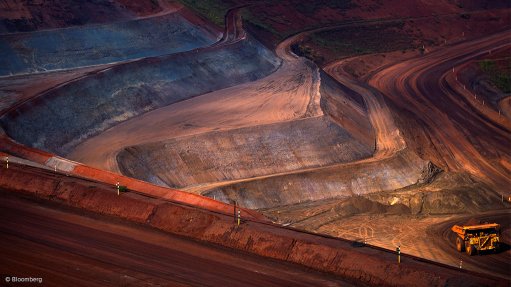
Photo by: Bloomberg
JOHANNESBURG (miningweekly.com) – As the next phase of the Zanaga iron-ore project starts, Zanaga Iron Ore Company (ZIOC) expects to cut the project’s capital expenditure costs from a single-stage $7.5-billion development to a two-stage $4.7-billion ramp-up.
Nonexecutive chairperson Clifford Elphick said the recently completed GlencoreXstrata-managed feasibility study showed that a multistage development of the Congo-based mine had “significant advantages” over the 2012 prefeasibility study (PFS), which had considered a single-stage 30-million-tonne-a-year development at a capital cost of $7.5-billion.
“The revised staged development approach has resulted in major improvements through substantial reductions in capital costs, lower capital and execution risk, and maximised capital returns,” he explained.
The Stage 1 development to an initial 12-million tonnes a year of high-quality iron-ore product was expected to cost $2.2-billion, while the Stage 2 expansion to a 30-million-tonne-a-year capacity would cost $2.5-billion.
Further, the first-stage operation could potentially finance the second-stage expansion through project cash flows, limiting the level of additional equity required for the operation, Elphick commented.
The bottom quartile operating costs presented by the PFS had been maintained, with a $32/t free-on-board (FOB) bottom quartile operating cost, including royalty, during Stage 1, and $26/t FOB bottom quartile operating cost, including royalty, during Stage 2.
Liberum’s mining team said that the project economics remained robust despite materially weaker iron-ore prices, with the higher recoveries and feed grade in the early years also aiding the economics of the project.
“Inputing the feasibility study estimates, we calculate a 16% internal rate of return using a long-run iron-ore price of $90/t cost and freight to China – versus our $98/t estimate – driven primarily by low operating expenditure (opex) and grade premium,” the group said.
The Stage 1 cash flows and project returns would be increased by mining the higher-grade near-surface ore for the first eight years of the operation’s 30-year mine life.
“Phase 2 will offer superior economics with capital intensity of $138/t and opex of $26/t FOB, and will be fundable without additional equity and potentially without additional debt if iron-ore stays at $110/t,” Liberum noted.
The Stage 2 expansion – by 18-million tonnes a year – to the 30-million-tonne-a-year target would comprise the openpit mining of the magnetite orebody.
Following the completion of the feasibility study and a social- and environmental-impact assessment, ZIOC had submitted an application for the project’s mining licence and environmental permit with the Ministries of Mines and Geology and Environment respectively.
Liberum noted that when the applications were returned – before the end of the year – ZIOC would be in a position to bring in a third party through a sell down from Zanaga and/or GlencoreXstrata.
“With the feasibility study now complete, a mining licence is the final hurdle to be delivered before a third party could be realistically brought into the project. In the interim, we expect GlencoreXstrata will continue to work on delivering key engineering, procurement and construction management contracts for the transport corridor and the processing plant, which should provide a large part of the debt, leaving a relatively small equity component,” the Liberum mining team said.
ZIOC had entered negotiations with international contractors regarding the mining convention as ZIOC prepared for the start of the front-end engineering and design early in 2015.